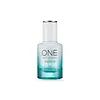What's inside
What's inside
 Key Ingredients
Key Ingredients

 Benefits
Benefits

 Concerns
Concerns

 Ingredients Side-by-side
Ingredients Side-by-side

Ocimum Basilicum Extract
AntioxidantFoeniculum Vulgare Fruit Extract
EmollientArtemisia Vulgaris Extract
Skin ConditioningSilybum Marianum Extract
Skin ConditioningAlcohol Denat.
AntimicrobialMethylpropanediol
SolventButylene Glycol
HumectantFomes Officinalis Extract
Skin ProtectingWater
Skin ConditioningPortulaca Oleracea Extract
Skin ConditioningGlycosyl Trehalose
Emulsion StabilisingHydrogenated Starch Hydrolysate
HumectantEpilobium Angustifolium Flower/Leaf/Stem Extract
Skin ConditioningGlycine Soja Sprout Extract
EmollientMagnolia Kobus Bark Extract
Skin ConditioningAllantoin
Skin ConditioningSodium Hyaluronate
HumectantCarbomer
Emulsion StabilisingPPG-26-Buteth-26
Skin ConditioningPEG-40 Hydrogenated Castor Oil
EmulsifyingTromethamine
BufferingPhenoxyethanol
PreservativeEthylhexylglycerin
Skin ConditioningDisodium EDTA
Caprylyl Glycol
EmollientCaprylhydroxamic Acid
Parfum
MaskingOcimum Basilicum Extract, Foeniculum Vulgare Fruit Extract, Artemisia Vulgaris Extract, Silybum Marianum Extract, Alcohol Denat., Methylpropanediol, Butylene Glycol, Fomes Officinalis Extract, Water, Portulaca Oleracea Extract, Glycosyl Trehalose, Hydrogenated Starch Hydrolysate, Epilobium Angustifolium Flower/Leaf/Stem Extract, Glycine Soja Sprout Extract, Magnolia Kobus Bark Extract, Allantoin, Sodium Hyaluronate, Carbomer, PPG-26-Buteth-26, PEG-40 Hydrogenated Castor Oil, Tromethamine, Phenoxyethanol, Ethylhexylglycerin, Disodium EDTA, Caprylyl Glycol, Caprylhydroxamic Acid, Parfum
Ingredients Explained
These ingredients are found in both products.
Ingredients higher up in an ingredient list are typically present in a larger amount.
Alcohol Denat. is an alcohol with a denaturant property. It is created by mixing ethanol with other additives.
This ingredient gets a bad rep because it is irritating and drying - mostly due to its astringent property. Astringents draw out natural oils in tissue, constricting pores and leaving your skin dried out.
However, alcohol denat. is not all that bad.
Due to its low molecular weight, alcohol denat. tends to evaporate quickly. One study on pig skin found half of applied alcohol evaporated in 10 seconds and less than 3% stayed on skin.
This also helps other ingredients become better absorbed upon application.
Studies are conflicted about whether this ingredient causes skin dehydration. One study from 2005 found adding emollients to propanol-based sanitizer decreased skin dryness and irritation. Another study found irritation only occurs if your skin is already damaged.
Small amounts of alcohol are generally tolerated by oily skin or people who live in humid environments.
The rule of thumb is if this alcohol is near the end of an ingredients list, it will probably not affect your skin much.
Also...
This ingredient has antimicrobial and solvent properties.
The antimicrobial property helps preserve products and increase their shelf life. As a solvent, it helps dissolve other ingredients.
Other types of astringent alcohols include:
Learn more about Alcohol Denat.Allantoin is a soothing ingredient known for its protective and moisturizingg properties. Because of this, it is often added to products with strong active ingredients.
Studies show higher concentrations of this ingredient can promote wound healing.
Though it can be derived from the comfrey plant, allantoin is produced synthetically for cosmetic products to ensure purity.
Learn more about AllantoinButylene Glycol (or BG) is used within cosmetic products for a few different reasons:
Overall, Butylene Glycol is a safe and well-rounded ingredient that works well with other ingredients.
Though this ingredient works well with most skin types, some people with sensitive skin may experience a reaction such as allergic rashes, closed comedones, or itchiness.
Learn more about Butylene GlycolCarbomer is a polymer of acrylic acid. Its main role is to create a gel consistency.
A high amount of carbomer can cause pilling or balling up of products. Don't worry, most products contain 1% or less of carbomer.
Disodium EDTA plays a role in making products more stable by aiding other preservatives.
It is a chelating agent, meaning it neutralizes metal ions that may be found in a product.
Disodium EDTA is a salt of edetic acid and is found to be safe in cosmetic ingredients.
Learn more about Disodium EDTASodium Hyaluronate is hyaluronic acid's salt form. It is commonly derived from the sodium salt of hyaluronic acid.
Like hyaluronic acid, it is great at holding water and acts as a humectant. This makes it a great skin hydrating ingredient.
Sodium Hyaluronate is naturally occurring in our bodies and is mostly found in eye fluid and joints.
These are some other common types of Hyaluronic Acid:
Learn more about Sodium HyaluronateWater. It's the most common cosmetic ingredient of all. You'll usually see it at the top of ingredient lists, meaning that it makes up the largest part of the product.
So why is it so popular? Water most often acts as a solvent - this means that it helps dissolve other ingredients into the formulation.
You'll also recognize water as that liquid we all need to stay alive. If you see this, drink a glass of water. Stay hydrated!
Learn more about Water